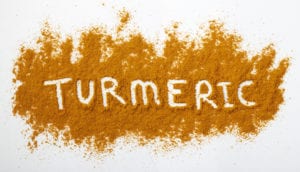Written by Angeline A. De Leon, Staff Writer. In a mouse model of ulcerative colitis, a combination of turmeric essential oils and curcumin significantly decreased disease severity compared to controls.
 In the field of complementary medicine, curcumin, the most active constituent in turmeric, has a well-established history of therapeutic use, with applications ranging from arthritis and depression to anorexia and chronic inflammatory diseases 1. Newer research also shows that like turmeric, essential turmeric oils (ETO), comprised of aromatic-turmerones (ketones with anti-cancer effects), also possess critical anti-inflammatory and anti-oxidant properties 2, with the added benefit of enhanced bioavailability in the body 3. In fact, curcumin complexed with essential turmeric oils (ETO-curcumin) has been shown to be up to ten times more absorbable, compared to standard curcumin 4. ETO-curcumin also demonstrates powerful anti-tumor properties in cancer studies 5. Recent evidence indicates that curcumin may be helpful in managing inflammatory disorders such as ulcerative colitis (UC, an inflammatory bowel disease affecting the digestive tract) 6, by attenuating inflammatory burden. However, its exact mechanism of action is still under study. In a study published in Scientific Reports, researchers at Baylor University conducted a comparative trial looking at the anti-inflammatory effects of ETO-curcumin vs. standard curcumin in animal models of dextran sulfate sodium-induced colitis (DSS).
In the field of complementary medicine, curcumin, the most active constituent in turmeric, has a well-established history of therapeutic use, with applications ranging from arthritis and depression to anorexia and chronic inflammatory diseases 1. Newer research also shows that like turmeric, essential turmeric oils (ETO), comprised of aromatic-turmerones (ketones with anti-cancer effects), also possess critical anti-inflammatory and anti-oxidant properties 2, with the added benefit of enhanced bioavailability in the body 3. In fact, curcumin complexed with essential turmeric oils (ETO-curcumin) has been shown to be up to ten times more absorbable, compared to standard curcumin 4. ETO-curcumin also demonstrates powerful anti-tumor properties in cancer studies 5. Recent evidence indicates that curcumin may be helpful in managing inflammatory disorders such as ulcerative colitis (UC, an inflammatory bowel disease affecting the digestive tract) 6, by attenuating inflammatory burden. However, its exact mechanism of action is still under study. In a study published in Scientific Reports, researchers at Baylor University conducted a comparative trial looking at the anti-inflammatory effects of ETO-curcumin vs. standard curcumin in animal models of dextran sulfate sodium-induced colitis (DSS).
A total of 15 male mice (five weeks old) were induced with chronic colitis by administration of DSS dissolved in drinking water. Severity of colitis was evaluated daily after DSS treatment using disease activity index (DAI, measuring changes in body weight, stool consistency, and fecal blood). Mice belonging to the treatment arm were administered either ETO-curcumin (n = 10) or standard curcumin (n = 10) at a dose range of 5, 25, and 50 mg/kg daily for seven days. A smaller group of five mice were allocated to untreated control.
At a treatment dose of 25 mg/kg body weight, both ETO-curcumin and standard curcumin groups resulted in decreased severity of colitis, compared to control, based on DAI scores on Day 6 (p < 0.001, p < 0.01, respectively). Both treatment groups also showed lower histological scores, relative to control (p < 0.01, p < 0.05, respectively). At a treatment dose of 50 mg/kg body weight, ETO-curcumin was associated with significantly lower DAI at Day 7, compared to both control and standard curcumin (p < 0.001, p < 0.05, respectively). Also, although both ETO-curcumin and standard curcumin were equally effective in maintaining fecal consistency (both p < 0.05, compared to control), ETO-curcumin was superior to standard curcumin in maintaining body weight (p < 0.05). Analysis of colonic tissue samples also revealed that the expression of anti-inflammatory cytokines, IL-10 and IL-11, was significantly upregulated by ETO-curcumin, compared to controls (p < 0.01, p < 0.05, respectively).
Overall findings confirm that although both standard curcumin and ETO-curcumin effectively attenuate inflammatory burden, the anti-inflammatory efficacy of ETO-curcumin is significantly greater than that of standard curcumin, particularly at higher doses. Evidence also suggests that ETO-curcumin’s protective effects against colitis are accomplished through modulation of the immune response. Further work is needed to understand the effects of ETO-curcumin in a human model of ulcerative colitis.
Source: Toden S, Theiss AL, Wang X, et al. Essential turmeric oils enhance anti-inflammatory efficacy of curcumin in dextran sulfate sodium-induced colitis. Scientific Reports. 2017; 7: 814. DOI: 10.1038/s41598-017-00812-6.
© The Author(s) 2017. Creative Commons Attribution 4.0 International License http://creativecommons.org/licenses/by/4.0/.
Click here to read the full text study.
Posted January 29, 2018.
References:
- Chandran B, Goel A. A randomized, pilot study to assess the efficacy and safety of curcumin in patients with active rheumatoid arthritis. Phytotherapy research. 2012;26(11):1719-1725.
- Singh G, Kapoor I, Singh P, De Heluani CS, De Lampasona MP, Catalan CA. Comparative study of chemical composition and antioxidant activity of fresh and dry rhizomes of turmeric (Curcuma longa Linn.). Food and Chemical Toxicology. 2010;48(4):1026-1031.
- Maheshwari M. Comparative bioavailability of curcumin, turmeric and Biocurcumax™ in traditional vehicles using non-everted rat intestinal sac model. Journal of Functional Foods. 2010;2(1):60-65.
- Antony B, Merina B, Iyer V, Judy N, Lennertz K, Joyal S. A pilot cross-over study to evaluate human oral bioavailability of BCM-95® CG (Biocurcumax™), a novel bioenhanced preparation of curcumin. Indian journal of pharmaceutical sciences. 2008;70(4):445.
- Buhrmann C, Kraehe P, Lueders C, Shayan P, Goel A, Shakibaei M. Curcumin suppresses crosstalk between colon cancer stem cells and stromal fibroblasts in the tumor microenvironment: potential role of EMT. PLoS One. 2014;9(9):e107514.
- Liu L, Liu YL, Liu GX, et al. Curcumin ameliorates dextran sulfate sodium-induced experimental colitis by blocking STAT3 signaling pathway. International immunopharmacology. 2013;17(2):314-320.

